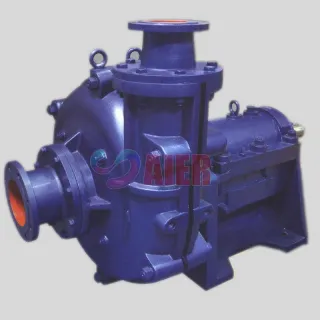Dec . 10, 2024 15:38 Back to list
wetted parts for slurry pump factories
Understanding Wetted Parts in Slurry Pump Factories
Slurry pumps are essential tools in many industrial applications, particularly in mining, construction, and wastewater treatment. They are specifically designed to handle mixtures of water and solid particles, known as slurries. One critical aspect of slurry pump design is the consideration of wetted parts—the components of the pump that are in direct contact with the slurry. Understanding wetted parts and their materials is crucial for optimizing pump performance, durability, and maintenance.
What are Wetted Parts?
Wetted parts are those components of the pump that come into contact with the fluid being pumped. In the context of slurry pumps, these parts include, but are not limited to, the impeller, casing, wear parts, and the suction and discharge connections. The selection of materials for these components is vital, as they must withstand not only the mechanical stresses of operation but also the corrosive and erosive properties of the slurry.
Importance of Material Selection
The materials used for wetted parts influence the efficiency and longevity of a slurry pump. Slurries can contain abrasive materials such as sand, gravel, or iron ore, which can wear down components quickly if the wrong materials are chosen. Common materials used for wetted parts include high-chrome iron, rubber, and various alloys.
1. High-chrome Iron This material is often used for impellers and liners due to its excellent wear resistance. High-chrome iron can endure the harsh conditions of slurry pumping, making it a popular choice for heavy-duty applications.
2. Rubber Linings For less abrasive slurries, rubber might be used to create a flexible and wear-resistant lining. Rubber linings can absorb shocks and vibrations, which helps to protect the pump's structure and reduce noise.
3. Alloys Some slurry pumps utilize specialized alloys designed to resist both wear and corrosion. These alloys can provide extended service life in applications where chemical compatibility is a concern.
Factors Influencing Wetted Parts Design
wetted parts for slurry pump factories

The design of wetted parts is influenced by several factors
- Type of Slurry The composition, density, and temperature of the slurry dictate the material properties required for the wetted parts. For instance, highly abrasive slurries necessitate harder materials, while corrosive slurries might require resistant materials.
- Pump Configuration The design of the pump—whether it is a centrifugal, positive displacement, or other types—also affects the choice of wetted parts. Each design has specific operational characteristics that demand different material considerations.
- Operating Conditions Factors such as flow rate, pressure, and duration of use play a role in the wear and tear of wetted components. Pumps operating under high pressure or in continuous cycles may require more robust materials.
Maintenance and Replacement of Wetted Parts
Even with the best materials, wetted parts will eventually experience wear. Regular maintenance is crucial to ensure that a slurry pump operates efficiently. This includes routine inspections for signs of wear, such as pitting, cracking, or erosion.
Replacement intervals will vary based on the slurry characteristics and the operational demands placed on the pump. Understanding when to replace wetted parts not only prevents unexpected breakdowns but also contributes to maintaining the overall efficiency of the pumping operation.
Conclusion
In summary, wetted parts are a crucial element in the design and functionality of slurry pumps. The appropriate selection of materials, based on the type of slurry and operating conditions, can significantly enhance pump performance and longevity. Awareness of the factors influencing the design and the importance of regular maintenance are fundamental to ensuring that slurry pumps operate at their best. By prioritizing the integrity and durability of wetted parts, industries can minimize downtime, optimize production, and ultimately extend the life of their equipment.
-
Top China Submersible Slurry Pump Supplier Durable & Efficient Solutions
NewsMay.17,2025
-
Submersible Pump Spares Manufacturer High-Quality & Durable Components
NewsMay.17,2025
-
Vertical Centrifugal Sump Pump Supplier China Factory Solutions
NewsMay.16,2025
-
Vertical Spindle Slurry Pump Suppliers High-Quality China Manufacturers
NewsMay.16,2025
-
High-Quality Casting Submersible Pump Parts Manufacturer Durable Solutions
NewsMay.16,2025
-
Vertical Sump & Mud Screw Slurry Pump Company Durable Solutions
NewsMay.15,2025
